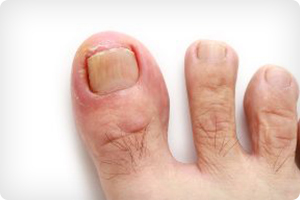An ingrown toenail can be uncomfortable causing swelling and redness, and has the potential to become infected. If you have an ingrown toenail, it is best to treat it immediately to reduce discomfort and allow the toe to heal quickly. People who have reduced circulation due to diabetes or other conditions are more at risk from complications to ingrown toenails. If you are concerned that you may have an ingrown toenail, we advise you schedule a consultation with The Foot Doctors of KC today.
Recognizing an Ingrown Toenail
The most common toe to develop an ingrown toenail is the big toe. You can tell whether or not you have an ingrown toenail if the edge of your nail grows into or under the skin. This can happen along the sides, corners, or front edge of the nail. Ingrown toenails cause the toe to become red and/or swollen. If you are not sure you have an ingrown toenail, call The Foot Doctors of KC to describe your symptoms.
How Do Ingrown Toenails Occur?
While it is possible for anyone to develop an ingrown toenail, there are a few circumstances that may lead to them:
- Cutting nails too short
- Wearing shoes that crowd your toes
- Injury to your toe and/or toenail
- Having curved toenails
What to Do if You Have an Ingrown Toenail
Home remedies for ingrown toenails may work, especially if you treat the nail as soon as you realize it has penetrated the skin. The Foot Doctors of KC recommend the following home treatments:
- Soaking your foot in warm water 3 to 4 times a day to reduce tenderness in the skin.
- Using topical antibiotic cream on the affected area to prevent infection.
- Wearing loose or open-toed shoes until your toe is healed.
If these home treatments do not cure your ingrown toenail within a few days, make an appointment with The Foot Doctors of KC. Early treatment can alleviate any discomfort and your toe will heal quickly. Your doctors may treat your toe in one of several ways:
- Trimming or removing the part of the nail that is embedded in the skin to allow the skin to heal.
- For someone who has repeated problems with the same toenail, permanently removing part or all of the nail.
- Prescribing oral antibiotics as necessary.
Preventing Ingrown Toenails
The best treatment for ingrown toenails is prevention. The Foot Doctors of KC recommend keeping feet clean and examining your feet daily. Regular trimming to keep your toenails at an optimal length, trimming the nails straight across, and wearing comfortable shoes that do not squeeze your toes will also help.
THIS INFORMATION IS NOT MEANT AS MEDICAL ADVICE- IT IS PROVIDED SOLELY FOR EDUCATIONAL PURPOSES. OUR PODIATRY OFFICES IN LEE’S SUMMIT MISSOURI AND BELTON, MISSOURI WOULD BE PLEASED TO DISCUSS YOUR UNIQUE CIRCUMSTANCES AND NEEDS AS THEY RELATE TO THESE TOPICS.


Recent Comments